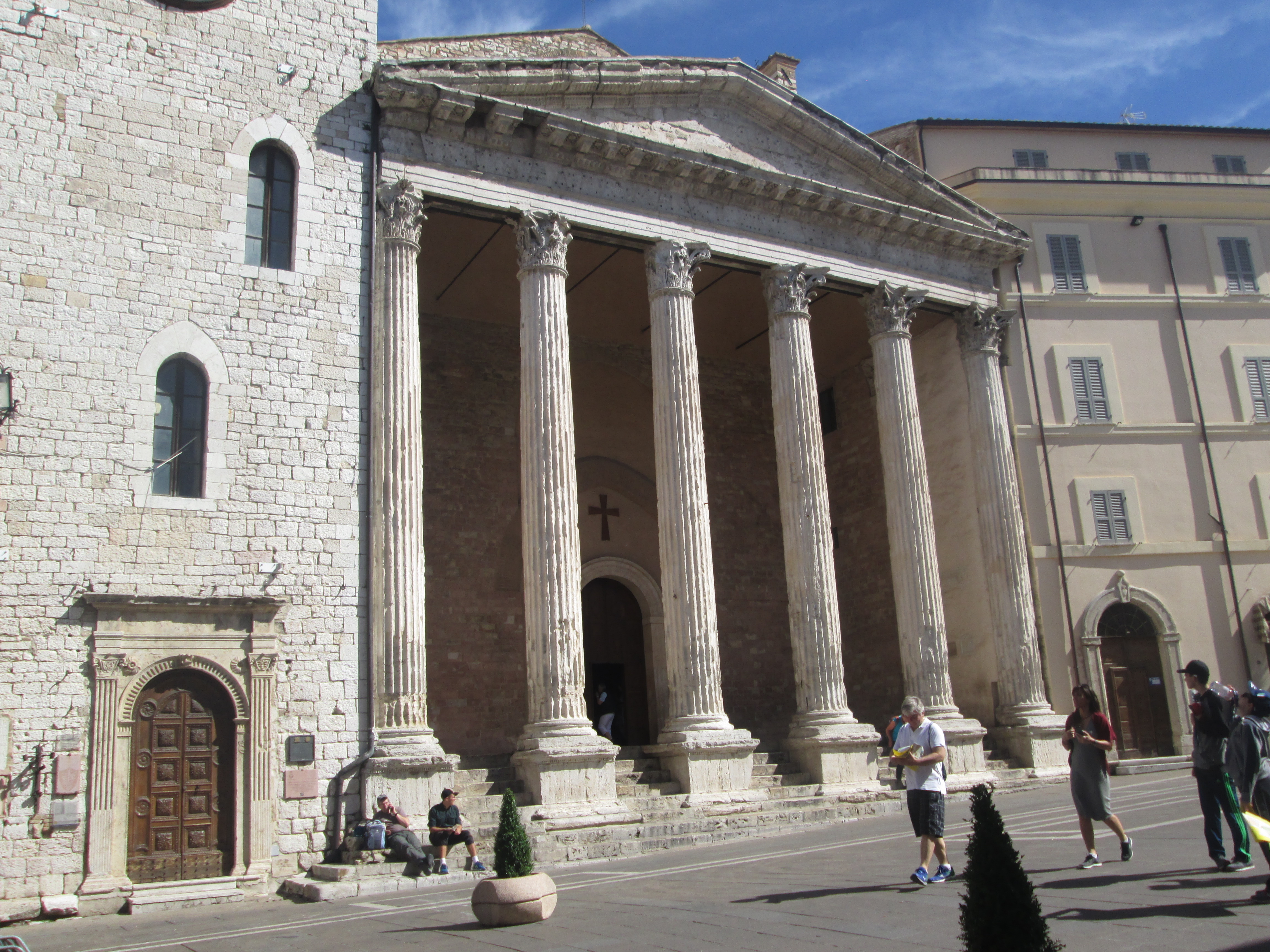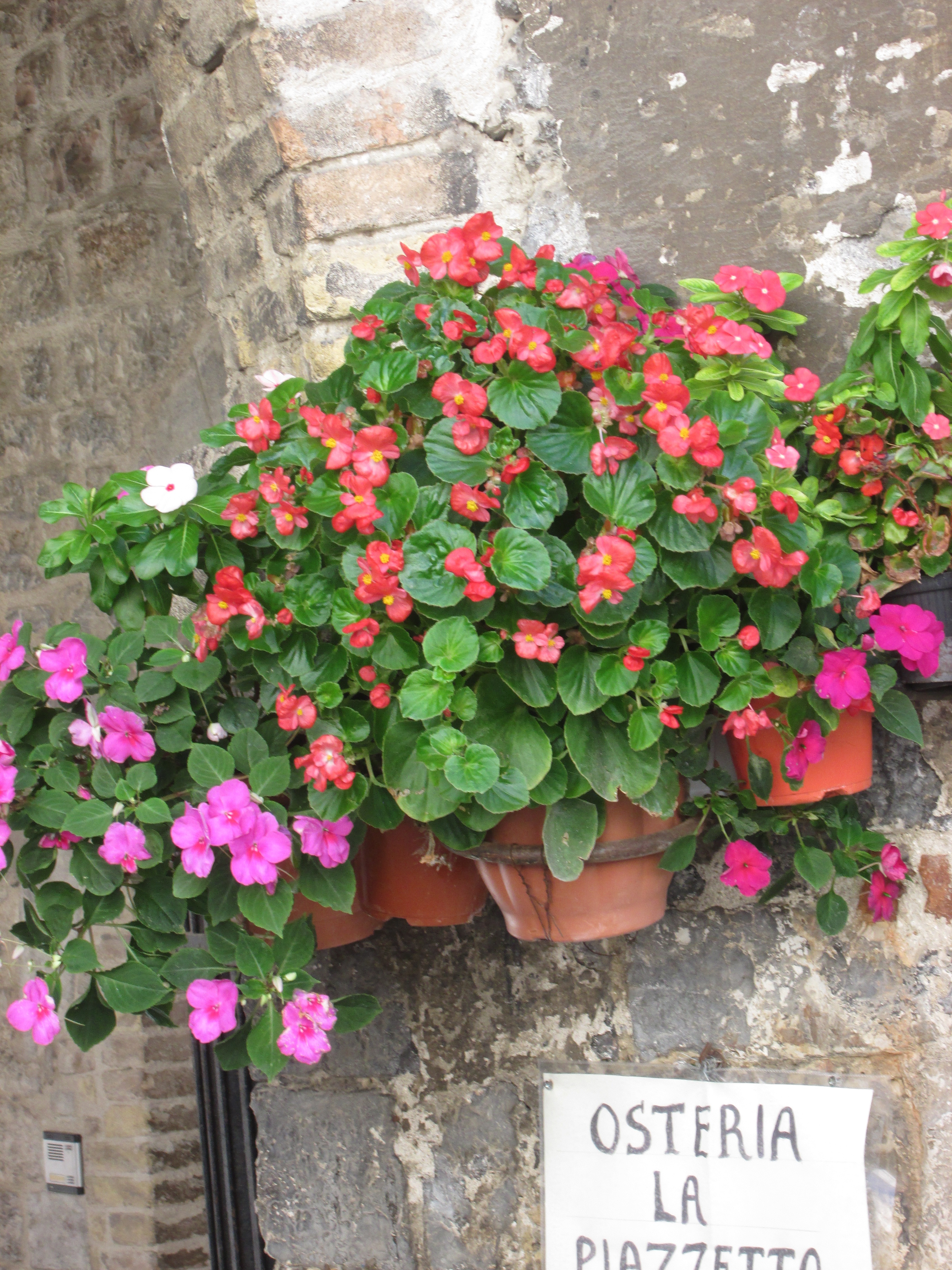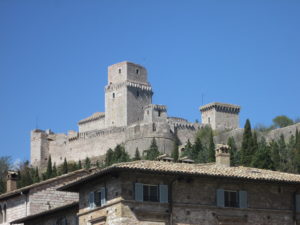
Assisi is a town and commune of Italy in the Province of Perugia in the Umbria region, on the western flank of Monte Subasio. It was the birthplace of St. Francis, who founded the Franciscan religious order in the town in 1208, and St. Clare (Chiara d’Offreducci), the founder of the Poor Sisters, which later became the Order of Poor Clares after her death. The 19th-century Saint Gabriel of Our Lady of Sorrows was also born in Assisi.
From this website Assisi
One of the most famous towns in Italy is Assisi, a UNESCO World Heritage Site, and, above all, homeland of St. Francis, the man who renounced all his possessions in order to devote his life to helping the needy. Dedicated to him is the splendid Basilica, one of the emblems of Christianity, located on Mount Subasio, from which it overlooks the entire valley, is dedicated to him. Apart from being a strong appeal for millions of religious believers, the Basilica is a monument of great artistic value.
St. Francis’s Basilica consists of two churches laid upon each other and a crypt containing the tomb of the Saint.
The Lower Basilica, with a double front portal, presents a simple facade embellished with a rose window and a mosaic. The interior is decorated with frescoes by some of the most important painters from 1200 to 1300, from Cimabue to Giotto and from the Lorenzettis to Simone Martini. The light that filters through the beautiful stained glass windows by Giovanni di Bonino and Puccio Capanna creates a very suggestive ambience.
In the Upper Basilica, it is possible to see the life cycle of St. Francis in frescoes painted by maestro Giotto, and the stories of the Old and New Testament covering the entire nave, and other wonderful frescoes by Cimabue and Torriti.
Another figure who has deeply influenced these places is Saint Clare, to whom the homonymous Basilica – presenting a facade made of white and pink stone and divided into three sections by horizontal cornices – is dedicated. The engaging interior frescoes and the remains of the Saint are visible through a window in the crypt.
The Duomo is dedicated to the other saint of Assisi, San Ruffino (St. Rufinus). It was rebuilt according to the design by Giovanni da Gubbio. The splendid Romanesque facade has three portals and, in the middle, a rose window surrounded by symbols of the Four Evangelists. The internal restructuring with three naves is attributed to Galeazzo Alessi, while works by Carlone, Giovanni Antonio Grecolini and del Giorgetti decorate the interior.
The Temple of Minerva is also a work of great interest; it is one of the best preserved Roman buildings, eventually becoming the Church of Saint Mary in 1539 and renovated in Baroque style in the 17th century.
_______________________________________________________
Our travel agent we used in Brisbane, Australia, turned out to be excellent. He used an Italian colleague who knew the area and the places for us to stay in. We were going by train from Rome and ending up at Bellagio, one the lakeside towns on Lake Como in northern Italy. We got off the train at Assisi Station and caught a taxi to the town of Assisi. The town eventually appeared on a low hill ahead of us …. it was spread over about a kilometre as a low stone town spread along the hillside. It looked fascinating …. and it was !! There was so much to see and experience !!
He took us to our hotel (the taxi driver said it was one of the best hotels in Assisi). We used the hotel as a base to explore Assisi over the next two days. We explored the hillside town of Assisi, perched on the steep slopes of Monte Subasio and overlooking sweeping plains below. We discovered the town from top to bottom as we wandered its squares and streets and stopped at the city’s spiritual heart, the Basilica of St Francis.
We uncovered the past of beautiful Assisi – this hillside medieval town, with its cluster of rosy-hued structures, which was the birthplace of St. Francis and is a famed centre for religious pilgrimage. We delved into the history of Italy’s patron saint and the Franciscan religious order that he founded as we toured the Basilica di San Francesco and the surrounding area.
The end of walking the kilometre or so, looking at the town of Assisi by photographs ….. the true beauty of the town can only be appreciated by going there for a few days. What is around the next corner to see and discover? There was so much to see !!
_______________________________________________________
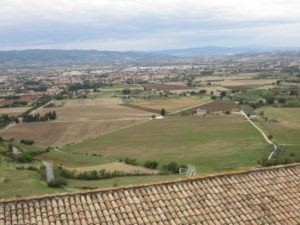
Looking over the surrounding countryside from the window of our hotel …. earth coloured terracotta rooves were on all the buildings
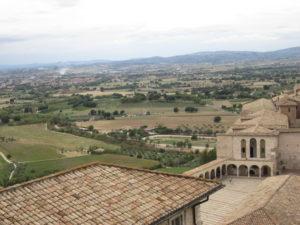
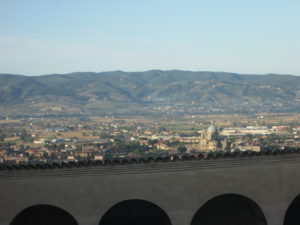
_________________________________________________________________________________________
Stone Buildings:

Harriet walking down a stone staircase ….. absolutely monumental !!
Streets are only for the few vehicles to enter and leave. Otherwise, streets provide pedestrians provide access through the town.
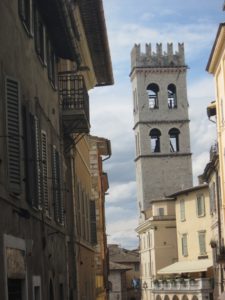
A stone bell tower to summon people to church
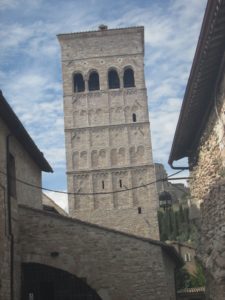
A different stone bell tower to the one above to summon people to church

Another hotel for tourists to stay in
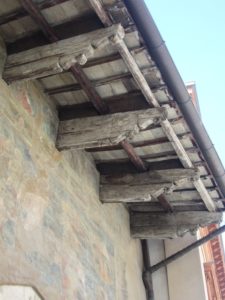
A wonderful projecting eave of a residence is a gentle contrast of timber against the stone
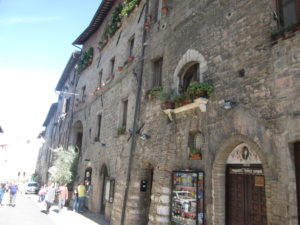
Stone walls with beautiful terracotta pots of plants on the walls
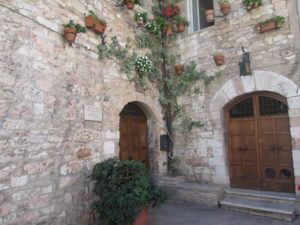
A photograph showing the beautiful soft pink stone blocks in the building. Each block is handcut and placed by hand. There is lot of creative stone mason work here in the way that small stone blocks are placed with larger blocks.
A beautiful stone arch. However did the stone masons build an arch like this when the stones are so heavy? If any one knows, e-mail me back.
A beautiful shop window set in the stone walling
_____________________________________________________________________
Temple of Minerva, Assisi
From Wikipedia, the free encyclopedia The Temple of Minerva (Italian: Tempio di Minerva) is an ancient Roman building in Assisi, Umbria, central Italy. It currently houses a church, Santa Maria sopra Minerva, built in 1539 and renovated in Baroque style in the 17th century.
The temple was built in the 1st century BC[1] by will of Gnaeus Caesius and Titus Caesius Priscus, who were two of the city’s quattuorviri and also financed the construction. The attribution to the goddess Minerva derives from the finding of a female statue, although a dedication stone to Hercules has been found, and the temple was likely dedicated to this male demi-god.[1] In the Middle Ages the temple housed a tribunal with an annexed jail, as testified by one of Giotto‘s frescoes in the St. Francis Basilica, which portrays the church windows with bars.
Of the ancient temple, the façade has been preserved, with six Corinthian columns supporting the architrave and a small pediment. The columns were originally covered by a very strong plaster, which was perhaps colored.[1] The cell was completely demolished during the church’s construction, in the 16th century, while a small section of the temple was found in the 20th century near the altar.
The temple was visited and described by the German poet Goethe during his travels in Italy, as the first ancient structure in good condition seen during his life (1786).[2]
Inside the church ….. a place of spiritual contemplation
A beautiful sloping street set amidst tall stone buildings. The open space of the street is in direct contrast to the closed in effect of the stone walls.
_____________________________________________________________________
Assisi Cathedral
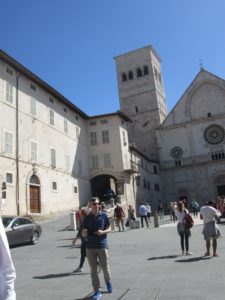
Assisi Cathedral: The Romanesque façade was built with stones from the Monte Subasio. It is a typical example of the style found in 12th-century churches of Umbria. This façade is divided in three sections. The rather bare top level is triangular with an empty semi-circular arch in the middle, probably intended to contain a frieze or a mosaic.
The middle level is divided by two pilasters, in line with the arch in the upper level. Each of the bay thus delineated contains a rose window, the central one the largest and the most ornate. Its frame is supported by three telamones, each standing on an animal. In the four spandrels around the rose window are the four animal symbols of the four evangelists.
The lower level consists of a number of squares and three decorated stone portals with griffins at the base of the side portals. Especially the middle portal is extensively decorated. In the lunette of the semi-circular arch over the central portal is a relief with the Christ enthroned between the sun and the moon and flanked by the Virgin, also enthroned and nursing Jesus, and St. Rufinus. The portal is surrounded with three arches decorated with saints, floral and geometrical motifs and intertwined swans. At the base of the middle arch, on each side, is a lion. These sculptures of lions and griffins have great iconographic importance.
The bottom and the middle part of the square bell tower, on the left side of the façade, were built in the 11th century. It was then situated behind the apse of the previous church built by bishop Ugone in 1029. The top level dates from the 13th century. One can see on the bell tower a colossal one-handed liturgical clock showing the 24 hours of the hora italica (Italian time), a period of time ending with sunset at 24 hours. The foundations of the bell tower rest on a Roman cistern. The structure on the side of the bell tower has been identified as the home of St. Clare.
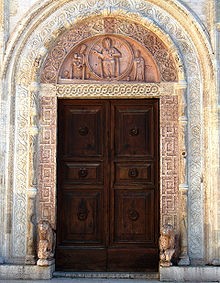
Central portal
Paving leading to the church
It is a rare thing to find open space created by a big stone paved courtyard which in direct contrast to the closed in effect of the stone walls of the buildings.
Harriet walking down along a stone paved street as open space but closed in by the stone arch at the end of the street
A beautiful stone arch with stone steps going down to another level. Steps have stone edges filled in by clay bricks
We came upon this large stone arch, one of many walking along among the many twisting streets
A clay terracotta colour of the big brick arch harmonies very well with the pink stone used in the walls beyond.
__________________________________________________________________________________________
Planted Courtyards Amidst Stone Walls:
A walkway into a residence is through big terracotta pots of plants ….. the wall of green is very inviting to the resident or visitor
____________________________________________________________________________________________
Shops in the Stone Buildings:
We came upon this wonderful gift shop … The Arte Legno shop
Inside the Arte Legno shop, it was just superb ….. it was filled with piece after piece of creative timber artifacts made from olive wood. The olive wood gives a wonderful flowing grain to each item: breadboards and bowls of many different sizes. Harriet and I could have stayed there for hours if we had time.
I was so taken with this stone wall outside the Arte Legno shop, I just had to bring a photograph of it home ….. it was so beautifulin the way large stone block merged with small stone blocks. It was a superb piece of creative stone masonry.
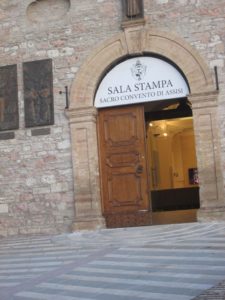
The little shops we would come upon were a delight to see and explore. It was as real people – experience amidst all the inert stone work of walls and streets
________________________________________________________________________________________
Stone and Brick Paved Streets:
There was such infinite variety in the many paved streets throughout Assisi …. most were of stone but occasionally were in brick like photograph below. This path led to
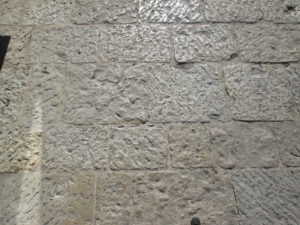

Handcut stone paving in a small side street
________________________________________________________________________________________
Special Items Along The Stone Paved Streets:
A timber seat was in a quiet contrast to the handcut stones of the paving and the walls
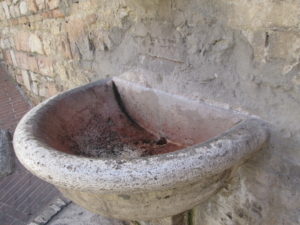
A stone wash basin if it were filled with water
Walking along among the many twisting streets, my wife Harriet came upon this beautiful red flowering shrub in a big terracotta pot
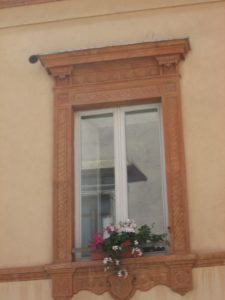

Stone steps leading up the doorway of a residence
A stone fountain with still water in the fountain basin ….. it would be wonderful to have the sound of falling and shimmering water in a public place
Wonderful flower planters on the stone wall are a wonderful addition to the beauty of the stone walls
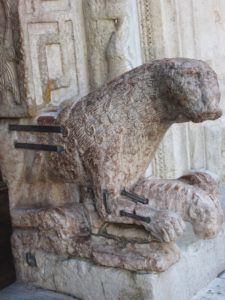
A carved stone Griffen sculpture …. see Griffin: Wikipedia, the free encyclopedia
________________________________________________________________________________________
Places to Eat:
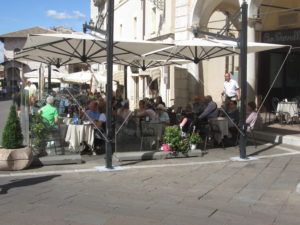
In Italian towns and cities is the ubiquitous pavement cafe where you get a coffee or have a wonderful meal. Pavement cafes are very communal places where you can go with family of friends and continue to build great friendships. In Australia where I come from, you buy your meal and often go somewhere to eat it ….. Community versus Pragmatism.
Harriet eating her lunch at the La Lanterna Restaurant in an outside garden area …. beautiful !!

The La Lanterna Restaurant sign at the end of the planted walkway as a photo shown below
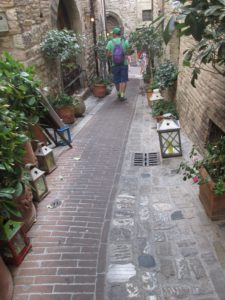
The wall of green is very inviting to the restaurant customer ….. this especially so when a restaurant staff member hands out advertising sheets out on the main footpath
________________________________________________________________________________________
Free Standing Stone Walls:
A beautiful free standing stone wall …. one of many in this ancient town
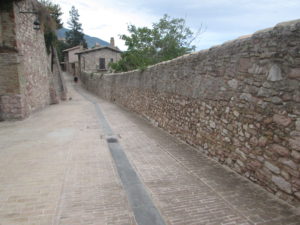
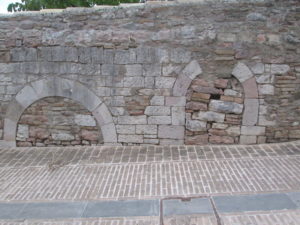
Another section of free standing stone wall …. had there been doors into a building a century ago ?
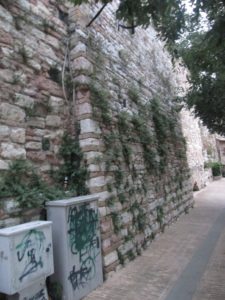
A standing stone wall with green plants spilling down the stone …… the plants and the stone work go well together
There is lot of creative stone mason work here in the way that small stone blocks are placed with larger blocks
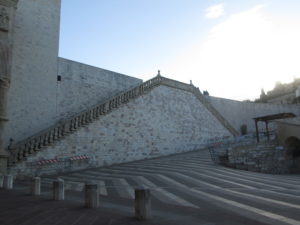
A free standing stone wall as part of the staircase at the Papal Basilica of Saint Francis of Assisi … the main cathedral
The combination of steps, the overhead stone arch and the wall of the building was Awesome !!
______________________________________________________________________________________________
The end of walking the kilometre or so, looking at the town of Assisi by photographs ….. the true beauty of the town can only be appreciated by going there for a few days. What is around the next corner to see and discover? There was so much to see !! I was really stuck by what my brother Rick and his wife Di said about Assisi. I was suddenly informed that they had been in Italy on a recent holiday and had stayed in Assisi for four days and used it as a base to go out from. They too loved the beauty of the town.
________________________________________________________________________________________________
See the next post: Trip 17: Assisi: The Hotel We Stayed In = 18th – 19th September 2017







